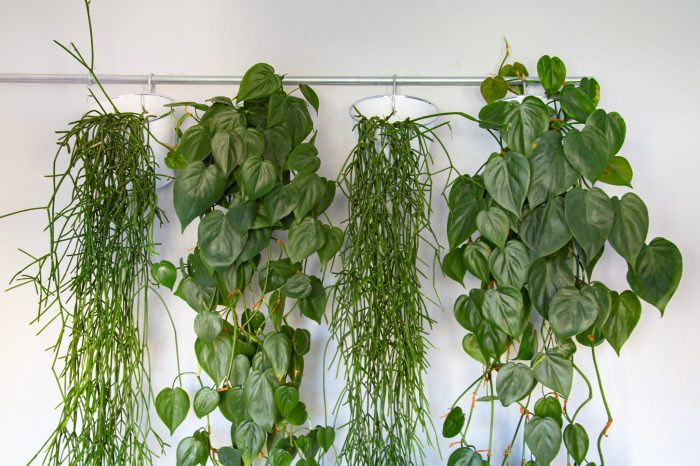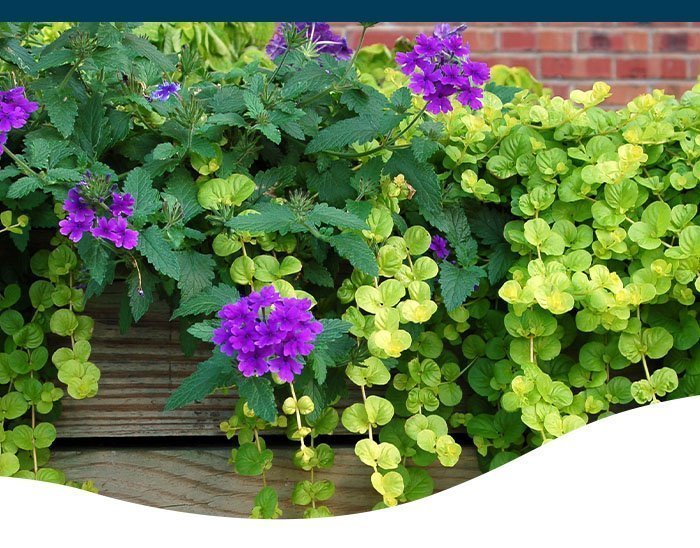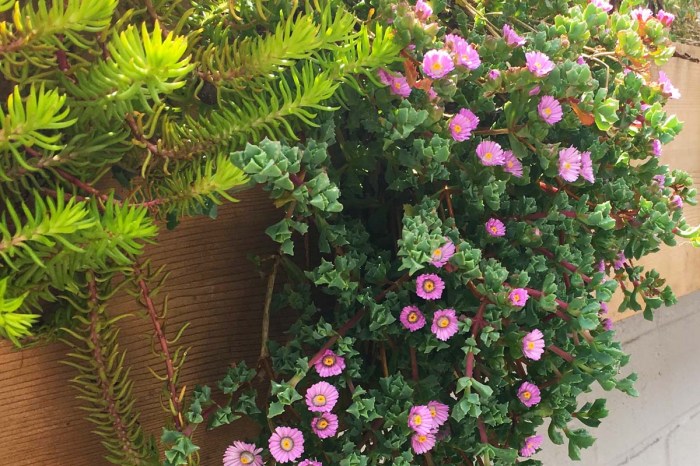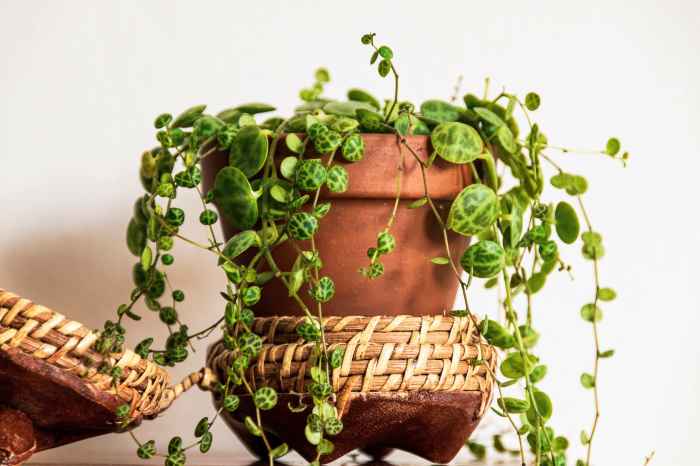8 different types of trailing plants – Delving into the captivating world of trailing plants, we uncover eight distinct varieties that grace landscapes and interiors with their enchanting charm. From cascading foliage to vibrant blooms, these plants offer a versatile canvas for creative expression.
Their unique growth habits and adaptability make trailing plants ideal for various settings, whether adorning hanging baskets, creating vertical gardens, or adding a touch of elegance to groundcovers. Explore their diverse characteristics and discover the art of incorporating these botanical wonders into your surroundings.
Define trailing plants

Trailing plants, characterized by their long, cascading stems that gracefully trail over surfaces, are a versatile and visually appealing addition to any landscape or interior design scheme. They thrive in environments with ample light and well-drained soil, making them ideal for both outdoor and indoor spaces.
The unique growth habit of trailing plants allows them to create a dramatic and eye-catching effect, adding depth and dimension to any setting.
Classify trailing plants

Trailing plants, characterized by their cascading stems that gracefully flow over the edges of containers or hang from baskets, add a touch of elegance and visual interest to any indoor or outdoor space. They come in a diverse range of species, each with its unique foliage, growth habits, and care requirements.
To help gardeners navigate the world of trailing plants, we have compiled a table that categorizes eight popular varieties based on their scientific names, common names, descriptions, and ideal growing conditions. This table provides a comprehensive overview of the different types of trailing plants available, making it easier for enthusiasts to choose the perfect species for their specific needs.
Scientific Name, Common Name, Description, and Ideal Growing Conditions
The following table presents eight different types of trailing plants, along with their scientific names, common names, brief descriptions, and ideal growing conditions, including light, water, and soil requirements.
| Scientific Name | Common Name | Description | Ideal Growing Conditions |
|---|---|---|---|
| Epipremnum aureum | Golden Pothos | A fast-growing vine with heart-shaped, variegated leaves; tolerant of low light and infrequent watering. | Bright indirect light, moderate watering, well-draining soil. |
| Tradescantia zebrina | Wandering Jew | A trailing plant with purple-green striped leaves; known for its rapid growth and ease of care. | Bright indirect light, regular watering, well-draining soil. |
| Senecio rowleyanus | String of Pearls | A succulent with spherical, bead-like leaves; requires well-draining soil and infrequent watering. | Bright indirect light, infrequent watering, well-draining soil. |
| Ceropegia woodii | String of Hearts | A succulent with heart-shaped leaves; prefers bright indirect light and well-draining soil. | Bright indirect light, moderate watering, well-draining soil. |
| Sedum morganianum | Burro’s Tail | A succulent with fleshy, trailing stems; requires well-draining soil and infrequent watering. | Bright indirect light, infrequent watering, well-draining soil. |
| Dischidia nummularia | Button Fern | A unique trailing plant with round, button-shaped leaves; prefers humid environments and bright indirect light. | Bright indirect light, high humidity, well-draining soil. |
| Soleirolia soleirolii | Baby’s Tears | A low-growing, mat-forming plant with tiny, rounded leaves; requires moist soil and bright indirect light. | Bright indirect light, moist soil, well-draining soil. |
| Pilea peperomioides | Chinese Money Plant | A trailing plant with round, coin-shaped leaves; prefers bright indirect light and well-draining soil. | Bright indirect light, moderate watering, well-draining soil. |
Describe propagation methods

Propagating trailing plants allows you to create new plants from existing ones, providing a cost-effective and rewarding way to expand your collection. There are several methods used for propagating trailing plants, each with its advantages and disadvantages.
Stem Cuttings
Stem cuttings are the most common method of propagating trailing plants. It involves taking a cutting from a healthy stem and rooting it in soil or water. This method is relatively easy and can be used for most trailing plants.
However, it can be time-consuming and may not always be successful.
Whether you’re looking to add a touch of greenery to your home or create a lush indoor oasis, trailing plants are a great option. With their long, flowing stems, they can add drama and interest to any space. There are many different types of trailing plants to choose from, each with its own unique look and care requirements.
For more information on indoor plants, visit Plants Indoor . If you’re not sure which type of trailing plant is right for you, be sure to do some research before you buy. With so many different options to choose from, you’re sure to find the perfect plant to add to your home.
To propagate trailing plants by stem cuttings:
- Select a healthy stem that is at least 4 inches long.
- Make a clean cut below a leaf node.
- Remove the leaves from the bottom inch or two of the cutting.
- Dip the end of the cutting in rooting hormone.
- Plant the cutting in a pot filled with moist potting mix.
- Keep the soil moist and provide bright, indirect light.
Layering
Layering is a method of propagation that involves rooting a stem while it is still attached to the parent plant. This method is less common than stem cuttings but can be successful for trailing plants that are difficult to root from cuttings.
Discover the beauty of 8 different types of trailing plants, each adding a unique charm to your indoor space. From the cascading tendrils of ivy to the delicate foliage of string of pearls, these plants bring a touch of nature to any room.
For more inspiration on indoor hanging plants, explore Different Types of Indoor Hanging Plants: Beautify Your Home with Nature’ , a comprehensive guide to creating a lush and inviting indoor oasis with trailing plants.
To propagate trailing plants by layering:
- Select a healthy stem that is close to the ground.
- Make a small cut in the stem, about 1 inch long.
- Insert a toothpick or small stone into the cut to keep it open.
- Bury the cut portion of the stem in moist soil.
- Keep the soil moist and provide bright, indirect light.
Division
Division is a method of propagation that involves dividing a mature plant into two or more smaller plants. This method is best suited for trailing plants that form clumps or have rhizomes.
To propagate trailing plants by division:
- Dig up the mature plant.
- Carefully divide the plant into two or more smaller plants, ensuring that each division has a healthy root system.
- Replant the divisions in individual pots or in the garden.
- Water the plants well and provide bright, indirect light.
Discuss care and maintenance

Trailing plants are relatively low-maintenance plants, but they do have some specific care and maintenance requirements. Here are some general tips:
Watering
Trailing plants prefer to be watered regularly, but they should not be overwatered. Allow the soil to dry out slightly between waterings.
Fertilizing, 8 different types of trailing plants
Trailing plants should be fertilized monthly during the growing season. Use a balanced fertilizer diluted to half strength.
Eight different types of trailing plants, including pothos, philodendron, and spider plants, are perfect for adding a touch of greenery to your home. To elevate your indoor decor, consider using Decorative Indoor Plant Hangers to showcase these trailing plants, creating a stunning vertical garden that adds both style and freshness to your living space.
Pruning
Trailing plants can be pruned to control their growth and encourage flowering. Prune stems back to a healthy leaf node.
Trailing plants are an elegant addition to any indoor space, offering a touch of nature and greenery. From the cascading leaves of the String of Hearts to the delicate tendrils of the Spider Plant, there are eight different types of trailing plants to choose from.
For those seeking inspiration on how to incorporate these plants into their homes, Decorative Hanging Planters for Indoor Spaces: Enhance Your Home with Greenery provides a comprehensive guide to hanging planters and their benefits. With the right planter and care, these trailing plants can transform any room into a lush oasis.
Encouraging flowering
To encourage flowering, give trailing plants plenty of sunlight and water them regularly. Fertilize them monthly during the growing season.
Controlling growth
To control the growth of trailing plants, prune them regularly and avoid overwatering them.
Preventing common problems
Trailing plants are susceptible to a few common problems, including:
- Root rot: Caused by overwatering
- Mealybugs: Small, white insects that suck the sap from plants
- Spider mites: Tiny, red spiders that spin webs on plants
To prevent these problems, follow the care and maintenance tips above and inspect your plants regularly for pests and diseases.
Proper placement and support
Trailing plants can be grown in a variety of locations, including hanging baskets, pots, and window boxes. They need to be placed in a location where they will receive plenty of sunlight and have good drainage.
Trailing plants need support to grow properly. You can use a trellis, a stake, or a wire cage to support your plants.
Explore creative uses
Trailing plants offer a versatile and visually appealing way to enhance various settings. Their cascading foliage adds a touch of elegance and movement, creating a dynamic effect in both indoor and outdoor spaces.
Hanging baskets
Trailing plants are ideal for hanging baskets, allowing their foliage to cascade gracefully over the sides. This creates a stunning display that adds height and interest to patios, balconies, and entryways. Some popular trailing plants for hanging baskets include petunias, trailing begonias, and vinca.
Vertical gardens
Vertical gardens are a great way to maximize space and bring greenery into urban environments. Trailing plants can be incorporated into these vertical structures, creating a lush and vibrant wall of foliage. They help purify the air, reduce noise pollution, and provide a touch of nature to concrete surroundings.
Groundcovers
Trailing plants can be used as groundcovers to create a dense and attractive carpet of greenery. They help suppress weeds, retain moisture in the soil, and prevent erosion. Some popular trailing plants for groundcovers include creeping Jenny, ivy, and pachysandra.
Last Word: 8 Different Types Of Trailing Plants

The beauty of trailing plants lies in their versatility and adaptability. Whether cascading from hanging baskets, adorning walls in vertical gardens, or carpeting the ground, they bring a touch of elegance and tranquility to any space. Their unique growth habits and ease of care make them a popular choice for both novice and experienced gardeners alike.
Embrace the charm of trailing plants and let their graceful presence enhance the aesthetics of your surroundings.
FAQ Insights
What are the benefits of using trailing plants in landscaping?
Trailing plants offer numerous benefits in landscaping, including adding vertical interest, softening edges, creating privacy screens, and attracting pollinators.
How do I encourage flowering in trailing plants?
To encourage flowering in trailing plants, ensure they receive adequate sunlight, proper watering, and regular fertilization. Pruning can also stimulate flower production.
What are some common problems associated with trailing plants?
Common problems with trailing plants include root rot due to overwatering, yellowing leaves due to nutrient deficiencies, and pests such as aphids and mealybugs.